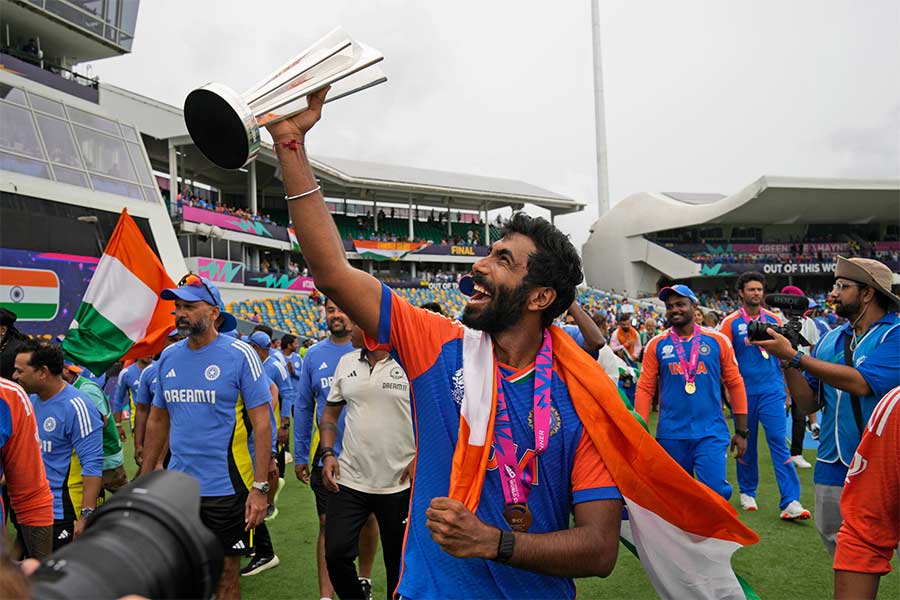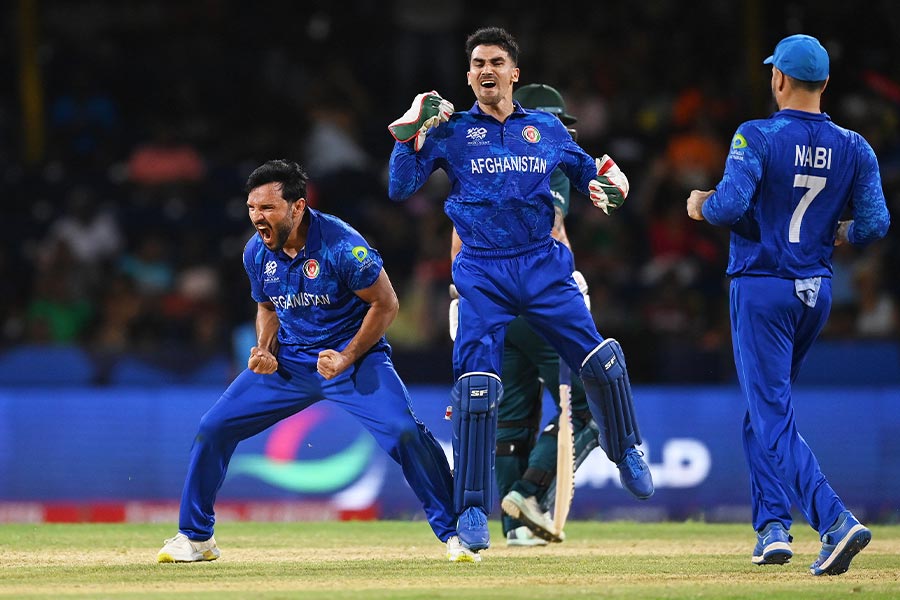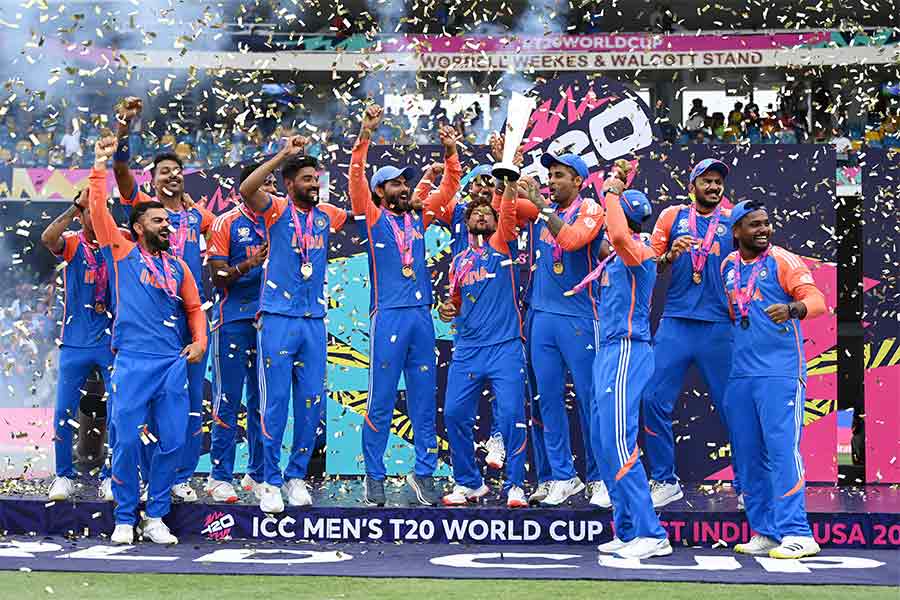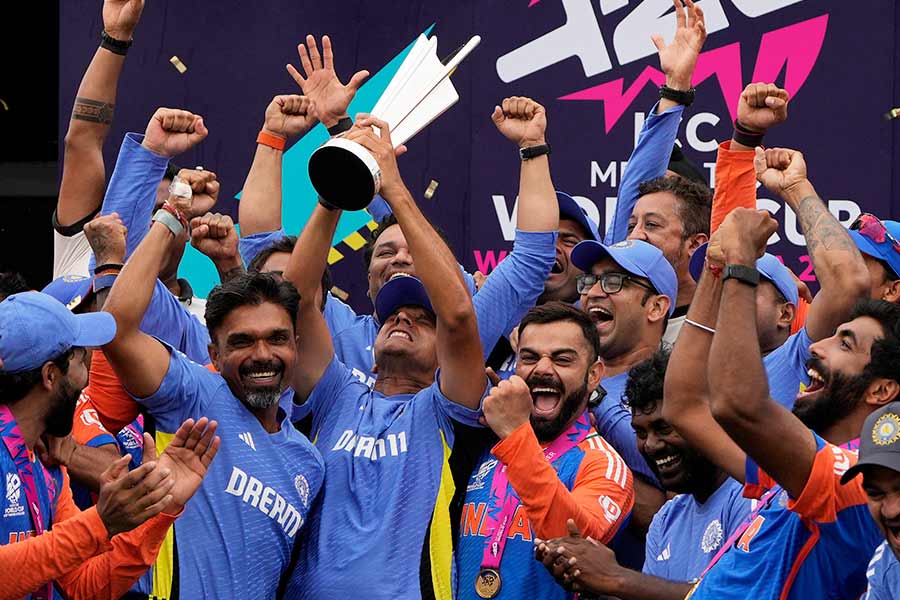#1 This tournament was a microcosm of life
All one could have taught a student of life was embedded in the tournament: rebounding after a setback, pursuing dreams impossible, overcoming odds through collaborative engagement, raising the bar at just the right moment, being tested by destiny’s scalpel, and learning never to yield. One could have taught more life lessons to students through the prism of this cricket tournament than through tedious NCERT history book gyaan imparted through 672 pages priced at Rs 345.
#2 Life is hundreds of preparation hours for three seconds of trial

Surya Kumar Yadav was as much a spectator of his own catch as he was the actor
Usain Bolt trained thousands of hours to be tested for less than 10 seconds, and for it to be recalled for 50 years (or more). There were a number of Usain moments in the tournament. Surya Kumar Yadav’s catch for instance (logged beside Kapil Dev’s catch to dismiss Viv Richards in the World Cup final in 1983), which will be remembered more for the ability to balance than the ability to catch or sprint. How many cricket academies will teach balance? How many will remember the South African wicket keeper’s presence of mind and laser throw that ran Axar out when he was returning harmlessly to the non-striker’s crease and had ceased attempting a run? How many will recall Klaasen’s calm under pressure? How many will care to think how the outcome of this tournament could have been different if Miller’s shot had just carried four feet higher or four feet wider? Some succeeded, some failed. Not because they were less or more competent; only because destiny was conspiring in some way to put the ball in the hands of people doing a trapeze act on the boundary line and least formally trained for it. Most people have discussed and dissected the catch; I would rather live with the amazement on Surya Kumar Yadav’s face. He was as much a spectator of his own catch as he was the actor.
#3 The T20 format is a social leveller

Perhaps USA would have never made it to the tournament had it not been a host; it made the last eight ICC
All those cricket friends who wrote extensively on cricket through the Eighties and Nineties screw up their nasal passage when reporting on the T20 format. Genuine reporting has become thankfully extinct; live television has transformed venerable commentators into quote-collectors at media conferences reduced to asking questions like ‘When will you retire?’ The flip side is that this format has turned millions of viewers into surgical professionals; the security gatemen at Udayan in Kolkata (the ones wearing the light blue-dark blue uniform and strutting around like fake authorities) were overheard this morning in the vernacular: ‘Kohli’s run rate dropped between ‘x and ‘y’ over; if he had sustained his earlier run rate, India could have added 12 runs and the match would have become a non-contest, Klaasen or not.’ That is the kind of stuff Gavaskar speaks. On a larger scale, this social levelling bit was reflected in Nepal losing to South Africa by one run (one more run and that could have transformed the future of the game in the world’s only Hindu kingdom), Afghanistan edging Australia out from the last four and USA defeating Pakistan from getting into the last eight. If this were a longer format, these outcomes may have smoothened out towards conventional outcomes; the shorter format provided octane to the underdog. And while I am on this, perhaps USA would have never made it to the tournament had it not been a host; it made the last eight. If this format were popularised the world over, in 20 years, Papua & New Guinea could be making it to the last eight some day. This is as close to the universal franchise that we can get in a competitive sport.
#4 Life is a cycle just as night follows day
Babar Azam is one of the world’s best, but failed through the tournament. Shaheen Afridi is a dreaded bowler but could not cut the ice. Kohli failed (relatively) through the tournament but delivered in the final. Rohit Sharma killed it for India through the tournament but mistimed it at the end. Hardik Pandya was booed (I should write ‘abused’) on Indian grounds but redeemed himself. Afghanistan outperformed in virtually every game but collapsed in the end. What is the common strain? That inconsistency was consistent. Fail one day, rise, go to work, fail again, go to work and then one day… The only consistent theme was India. Unbeaten through the tournament. Had South Africa won, Nepal could have claimed a ‘reverse bonus’ on the grounds that it almost beat the country that won. But sadly.
#5 The comeback artist is the winner

The biggest comeback artist of the tournament was the humble bowler. The Player of the T20 World Cup was a bowler PTI
We have heard this often: ‘It is never over until it is over’. Part believed; part sniggered. But when India won from a point when South Africa needed 30 in 30 balls with five standing – it could have got them by patting each ball to third man and walking their singles – I am beginning to believe that Anupam Kher’s overused hype (‘Kuch bhi ho sakta hai’). At 15.2, South Africa needed 27 in 28 (win predictor showed India's chance at 3.38% after 16 overs). Hopeless. See the sequence of what transpired thereafter: 1, 2, 0, 0, 1, 0, W, 0, 1, 1, 1, 1, 0, 0, 1, W0, 1, 0, 0, 1, 2, 1, 0, W, 4, B1, L1, Wd, W, 1. The winner is not necessarily the one who never goes down; the winner is the one who gets up each time. The only cricket analogy that comes close is Pakistan in the 1992 World Cup, losing match after match, hitting bottom, and turning around. When they were down and possibly one match from going home, Gavaskar is supposed to have said ‘Beware of the cornered tiger.’ And then you had Inzamam against New Zealand and Imran’s captaincy and all that (‘We are going to win the World Cup’ he told his bewildered side). When Pakistan celebrated, Gavaskar was invited as a guest. Because he had believed. But getting back to the main story. The biggest comeback artist of the tournament was the humble bowler. Virtually banished from the IPL. Sent to exile. Mocked by eight-year-olds. Shunned by selfie-seekers. The Player of the T20 World Cup was a bowler. Retrieved the game from a run orgy.
#6 One day the audacious will inherit the Earth

The prevailers will be those who reverse-sweep fast bowlers for six, flight off spin during the Power Play, sweep from outside the seventh off stump, slice above the wicket keeper and jump out to a left arm leg spinner Gareth Copley/Getty Images
With all due respects to the Bible, I am compelled to replace the word ‘meek’ with the ‘A’ word. The prevailers will be those who reverse-sweep fast bowlers for six, flight off spin during the Power Play, sweep from outside the seventh off stump, slice above the wicket keeper and jump out to a left arm leg spinner. Cricket’s book of risk management went into its 367th revision. Less and less are getting out to reverse sweeps. Mike Gatting, who lost his wicket ‘reversing’ a spinner during the World Cup 1987 final – the match turned from there – must be wincing at how fast bowlers are being arrogantly dismissed around the corners these days. The straight drive over the bowler’s head has ceased to be the Emperor of Strokes. The classic cover drive only elicits a ‘good.’ In one generation.
#7 The world belongs to the stress takers
The last half an hour of the tournament was the ‘180-120’ of the tournament. The hour belonged not to the one who was most skilled; it belonged to the one who kept his nerve. What does this mean? It means just when every run counted, you did not overstep, did not bowl a wide, did not bowl on the leg side and did not toss full. It means that you ran in and pitched just where you would have pitched in the first over before your batting turn. Fast. Line. Length. Movement. I could have written an essay on what must have been going through Hardik’s mind. Processing advice from Rohit. Processing the echo from the Wankhede. Processing the scorecard. Processing the required run rate. Processing a probable ‘Hardik ne marvaa diya’. His bowling was an act of courage. He did not weep and remove the lachrymals with his fingers for nothing at the end.
#8 Success is failure plus one transformative step
There is nothing like ‘We won because Kohli batted well’ or ‘We won because of that one catch.’ We won because of hundreds of things we may never be able to map. The universe conspired, period. We won because of the speed with which Kohli ran his second run as a non-striker. We won because of someone sliding at the boundary line to cut a boundary. We won because someone lay flat in the covers to stop a single. Hundreds of invisibles. They were not accounted for. Like in life. We have succeeded because we have stood on the shoulders of giants. I have a curious thought: what if Surya Kumar Yadav had dropped the catch? He would have been the national villain. Axar would have been crucified for yielding 24 runs in an over. Kohli would have been castigated for ‘Ab woh baat rahi nahi’. Rohit’s retirement announcement from this format would have evoked ‘Thank god.’ Someone would have risen to ask, ‘Who is this Dube fellow anyway?’ And there would have been a stray comment that ‘We overplayed the Jadeja card. I wonder if…’ Success fathers many. Failure is parentless.
#9 What’s your story?

Every Afghanistan player represented a story. Every USA player who balanced a day job with evening practice represented a story. Every Nepal player with as much hope as an icicle in hell of leaving any mark on the tournament represented a story Gareth Copley/Getty Images
At the end of the end, everyone wants to know where you come from. What is your story? What is your dream? What has been your struggle? There were a number of such stories during the tournament. Every Afghanistan player represented a story. Every USA player who balanced a day job with evening practice represented a story. Every Nepal player with as much hope as an icicle in hell of leaving any mark on the tournament represented a story. Half a dozen teams in the tournament must have asked for post-match selfies with their opponents after their matches. There was Netravalkar, Gulbadin and the names of so many I will never know who brought a distant dream of making a difference in the tournament. The world is full of such people. They go to work anonymously, put in a hard day’s toil with the conviction that in the final run it will matter, most of the time it does not appear to matter but every one of them contributed to the tournament’s emotional richness – to the point that I am almost compelled to step beyond my brief and state that this was possibly the most inclusive of all World Cups. Ever. If only the fellows sent by their newspapers could have written human-interest stories on the lives of some of the names we may struggle to pronounce (instead of filing unreadable dispatches), this would have been an even richer tournament. If you get what I mean.
#10 Money speaks our language but in a different tone
They said that the tournament was loaded in favour of India. Yes and no. No because the ICC did not bowl for us and definitely did not take that last frontier catch. We earned every one of those match wins. Yes, because we played in a stable slot timed with evening Indian prime time. If that had not transpired, it may have never registered to the largest population cluster in the world (equivalent to the audience of all participating countries put together) that a Saudi oil company sponsored the tournament with another Middle Eastern airline, and if they never derived any ‘turn’ from the sponsorship pitch, the T20 World Cup would be such a financially diluted event that there would have been a lower surplus to re-pump money into the game in Ireland, Uganda and Papua & New Guinea. There will be more cricketers in these countries because more Indians can watch their country play at 8pm. Our convenience is probably the biggest catalyst this game of cricket will ever know. The more we can slide into our sofas in air-conditioned comfort with a DND on our cellphones, the more someone in a distant African country will see the sense of rising at 6am with a singular dream: ‘To be a professional cricketer.’
PS. The eleventh lesson is that India would do well to include a Malayali in every tournament team. In 1983, we included Sunil Valson and we won the tournament; in 2007 and 2011, it was Sreesanth and this time it was Sanju Samson.


